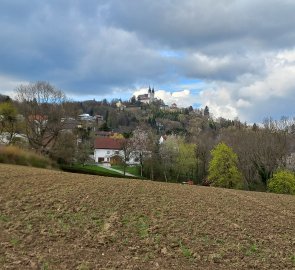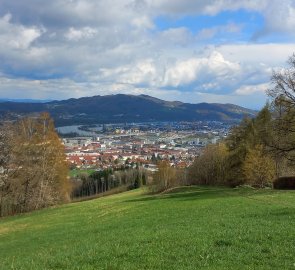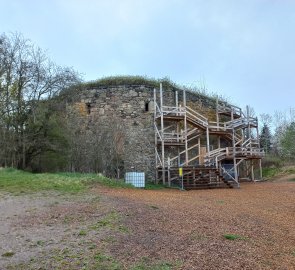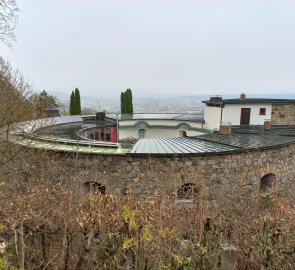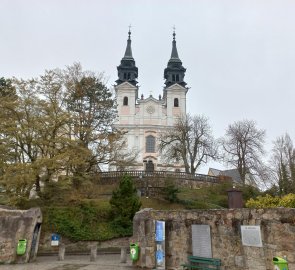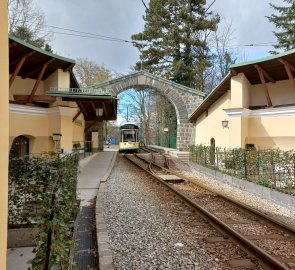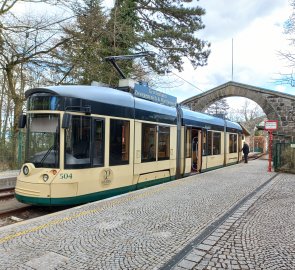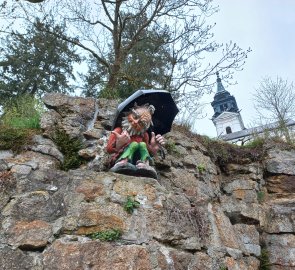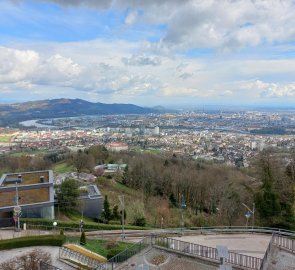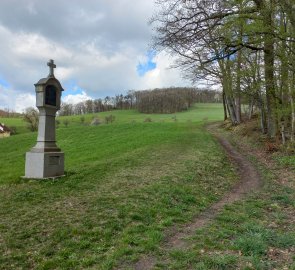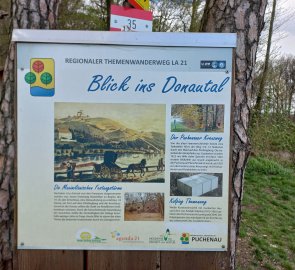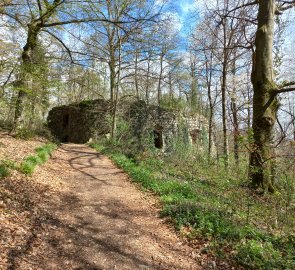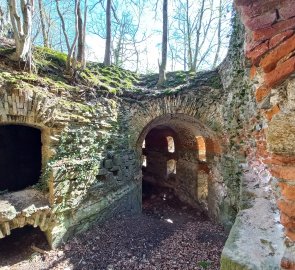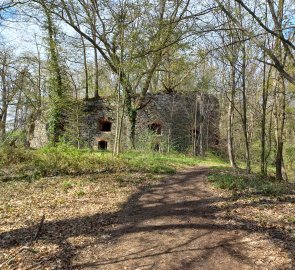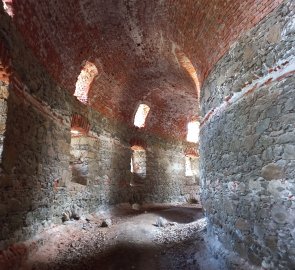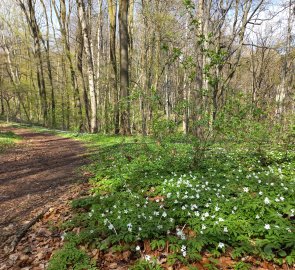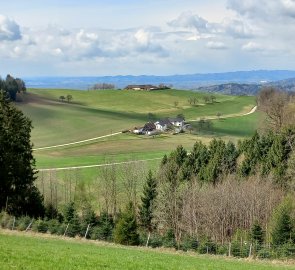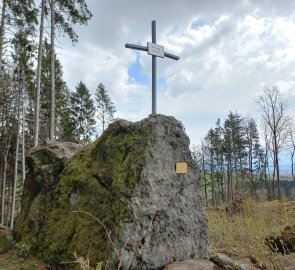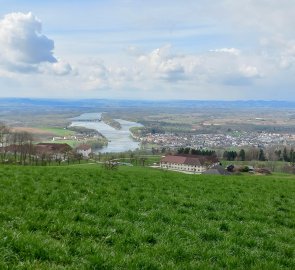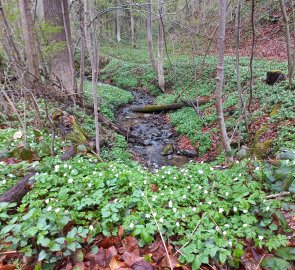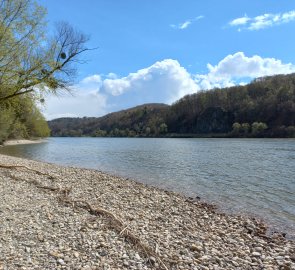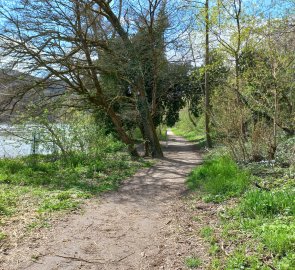Trip into the history of Linz - the forgotten towers
Mountain range, region / State
/ Austria
Season
Spring
03. 04. 2022
Difficulty
1 / 5
Elevation
↑ 888 m
↓ 887 m
Length
18.1 km
6 hours
Altitude
max. 629 m n.m.
min. 257 m n.m.
Tourist map of the Linz area in Austria
Tips for hikes in the mountain range
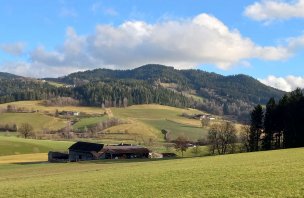
Hike across four scenic mountains near Freistadt, Austria
Hike throught forgotten towers near Linz
Starting point
Kreuzweg - the way of the cross to Pöstlingberg, starting at the Catholic Gymnasium -Bischöfliches Gymnasium Petrinum in Linz.
Description of the hike
I turn off the motorway in Linz at the exit to the Urfahr district, park the car in the residential area below Pöstlingberg and head up the Kreuzweg (cross road). The road leads up the slope, past the simple cemetery of soldiers killed in the First World War. After a few stops, I turn onto a dirt road to a round building in a meadow - the first tower of Turm 20 Cecilia. It is not accessible, but there is a wooden platform and benches in front of it overlooking the town.
I climb further towards the basilica and after a while recognise the next tower - Turm 19 Dorothea. The Dorothea has been converted into a dwelling house, with a wonderful view of the city and the bridges over the Danube. I cross the track of the narrow-gauge railway, which has its terminus in the Marie tower. This, together with four other towers, forms the fortifications of Pöstlingberg - Othilia, Beatrix, Euphemia, Nothburg. What did the towers get their names from? They were patron saints who protected their charges as the towers protected the city. From the observation deck below the basilica, I admire Linz again. Too bad it's April weather and visibility is poor, the snow-capped Alps peeking out in the distance only briefly.
I leave the top of the hill and head towards the Danube. By the road stands another tower of the 18th Katharina. The Katharina has also been converted into apartments, but the owners are keeping with tradition and have two cannons in the garden as decoration. I can't find the next Katharina in the woods, there is a raised mound in its place and only the street name Claraweg reminds me that there was once a tower here. About 200 metres from the houses I find the ruins of Seraphina in the woods. I follow the cross path down through the light floodplain forest towards Puchenau.
Now in April there are plantations of flowering anemones. I come across the only themed trail relating to the towers - the Turmweg, which bypasses the three other towers of Thekl, Luitgard and Edelburg. The last two are the best preserved, freely accessible and can be explored from the inside. They seem huge, about 20 m in diameter, with vaulted red-brick ceilings, round windows and several floors. However, they are both overgrown with trees and infestations, there are remnants of fireplaces, and there is no question of any monumental protection.
I didn't visit any more towers during the trip, because I wanted to look further into the Upper Austrian landscape. If you are interested in their fate, you can look them up on the German Wikipedia under "Turmbefestigung Linz". On the left bank of the Danube there is one more preserved tower. Turm 24 Ehrentrude crouches between the pillars of the Voestbrücke, the motorway bridge over the Danube.
Opposite it, on the other side of the bridge, the Winfriede tower has survived, but it has also been rebuilt. The eastern and southern parts of the ring of towers have been demolished. On the west side of Linz, about 5 towers remain standing, mostly converted into apartments. The Probeturm, which stands a little to the side of the ring and is part of the Catholic grammar school, has also survived.
The whole circuit along the tower traces is about 25 km long. The trip to Pöstlingberg, exploring and climbing the towers takes about 2-3 hours. I then extended my route by hiking along the marked hiking trail to the nearby hills of Koglerauer Spitz (685 m) and Hoher Dürnberg (549 m), which are decorated with pretty metal crosses and from the tops of which you can see the Danube.
From the Dürnberg I walked down a ravine full of flowering anemones and primroses to the Danube and along the Donaupromenade through the village of Puchenau back to Linz. The Donaupromenade is a beautiful relaxing path just beside the Danube, which leads through a meadow of willows and invites you to sit on the pebble-filled beaches. From Puchenau it is also possible to return by public transport or train.
Difficulty
An ordinary hike in rolling countryside, suitable for families with children and history enthusiasts. Pöstlingberg is a city mountain, still part of Linz, a forest park. The total elevation gain of the trek is about 880 m, so a good fitness is useful after all.
Water availability
On the Pöstlinberg there are restaurants and cafes, in the villages behind it everything was closed, it was better to take snacks with you.
Sleeping options
This is a day trip, accommodation possible in Linz.
Mountain peaks
City mountain Pöstlingberg 539 m above sea level, Koglerauer Spitz 685 m above sea level and Hoher Dürnberg 549 m above sea level. Beautiful views of Linz, the Danube and, with good visibility you can see part of the Austrian Alps.
Danger
Safe route suitable for children. It is in a city park, on wide paths or asphalt roads.
Food
I had food to go, restaurants and cafes on the Pöstlingberg, Jindrak Patisserie on the Pöstlingberg overlooking the city.
Attractions
The fortified towers of Turmbefestigung Linz, Pöstlingberg, the narrow-gauge railway Pöstlingbergbahn, the fairytale world with the electric train Grottenbahn.
Forgotten towers near Linz
When you come to Linz from the north, from the Czech border, you will see a hill with a big white church on the right above the city. The hill is called Pöstlingberg and on top of it stands the Baroque Basilica of Our Lady of the Seven Sorrows, one of Austria's most important pilgrimage churches. The Pöstlingberg is a popular destination for walks and hikes, and not only because of the basilica and the beautiful views from Linz to the Alps.
It is a good 300 metres from the Danube (the highest point is 539 metres above sea level) and takes less than an hour on foot. If you don't want to pedal, you can take the narrow-gauge Pöstlingbergbahn. It has been running since 1898 and is mainly used by families with children, who head to the top for another attraction - the fairytale world of the Grottenbahn.
If you zoom in on the map for a closer look, you will see that there are several towers on the Pöstlingberg. They are numbered and have women's names. A little history is needed here. Linz was of key importance because of its location. Archaeologists have found the remains of prehistoric settlements, the Celts founded an oppidum here called Lentos, and this name was later taken up by the Romans, who built the village of Lentia. In the Middle Ages the borders between the empires shifted and Linz was for some time part of Bavaria.
In the 18th and 19th centuries the town was occupied several times by German and French troops. After these experiences, at the beginning of the 19th century, Archduke Maximilian Joseph of Austria decided to protect Linz and build a ring of defensive towers around the city. This was an ambitious and costly project for its time, and it had many opponents. Therefore, Maximilian first built the Probeturm, a test tower, in 1828, which he had shelled in the presence of Emperor Franz I.
The tower came out of the severe test successfully and Archduke Maximilian was able to carry out his project. Between 1831 and 1833 he had 32 fortified towers, casemates and a fortress built on the Pöstlingberg. However, the towers served military purposes for only 20 years, after which development progressed and the defensive towers were no longer needed. Some were converted into houses, others were used as warehouses, but most of them fell victim to the construction of the city or fell into disrepair. Not even half of the 33 towers remain.
